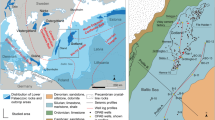Abstract
Deep Sea Drilling Project/Ocean Drilling Program Hole 395A was drilled approximately 500 m deep into young oceanic crust west of the Mid-Atlantic Ridge. Core recovery is very poor in this hole and therefore continuous downhole measurements are important to understand the drilled lithology. Geophysical downhole measurements were carried out during several cruises. A new set of logs was recorded during Leg 174B in summer 1997. The new logging data show a significant improvement in data quality compared to older measurements from Leg 109. The lithostratigraphy established from cores gives only limited information because of the poor core recovery in this hole. The gaps in the core lithostratigraphy are filled by reconstructing a synthetic lithological profile using the standard well-logging data. Three types of lava morphologies, massive basalts, altered lava flows, and pillow basalts, may be distinguished using the logs because the lava morphologies show differences in their physical properties due to differences in fracturing and alteration. The synthetic lithological profile gives a more detailed and precise vertical definition of single layers than the core profile. The integration of further logging and core data enables a detailed reconstruction of the accretion history at the drill site. Cyclic, upward decreasing trends in the resistivity logs were already observed during earlier cruises and were referred to magmatic cycles. Similar trends occur in the density log and, inversely, in the total gamma ray log. The trends reflect gradual changes in fracturing, porosity, permeability, and alteration and cover depth intervals of several tens of meters. Boundaries between cycles are interpreted to correspond to periods of volcanic quiescence. Two types of boundaries may be identified. Boundaries correlating with reversals in the magnetic field and/or changes in the geochemical composition of the basalts are interpreted as long pauses. Basalts separated by these boundaries were probably fed by separate magma reservoirs. Boundaries identified only by changes in alteration but not in geochemistry are interpreted to represent shorter pauses. They separate basalts that were probably fed by the same magma chamber.
Similar content being viewed by others
Author information
Authors and Affiliations
Rights and permissions
About this article
Cite this article
Bartetzko, A., Pezard, P., Goldberg, D. et al. Volcanic stratigraphy of DSDP/ODP Hole 395A: An interpretation using well-logging data. Marine Geophysical Researches 22, 111–127 (2001). https://doi.org/10.1023/A:1010359128574
Issue Date:
DOI: https://doi.org/10.1023/A:1010359128574




